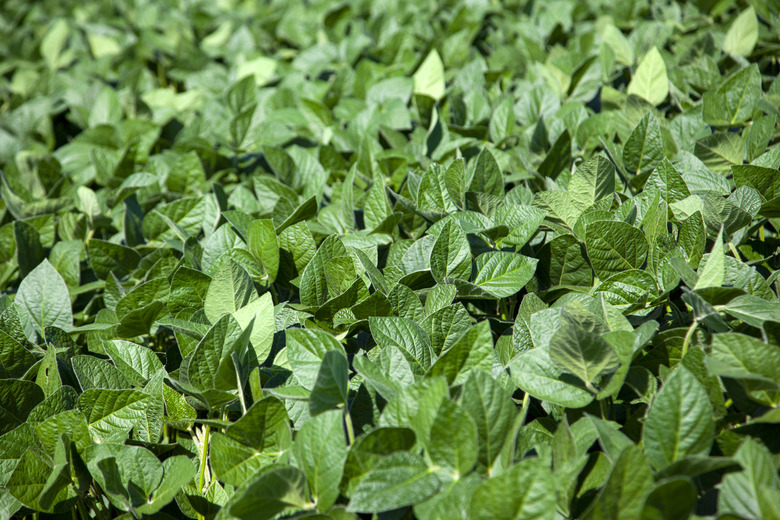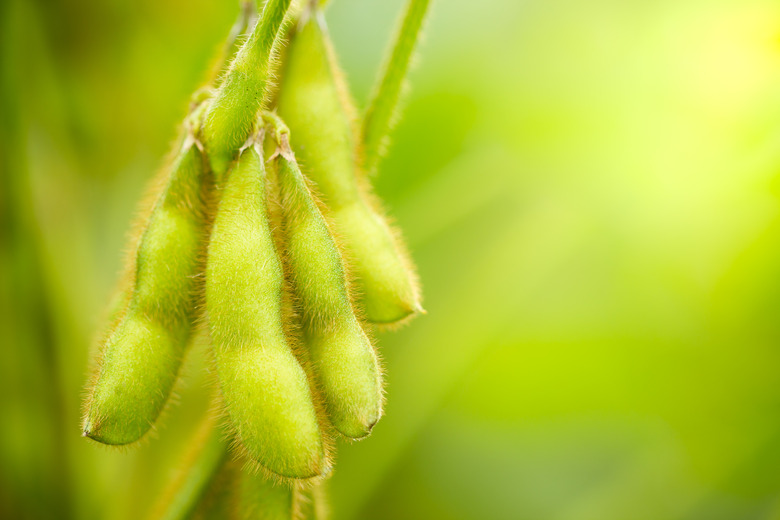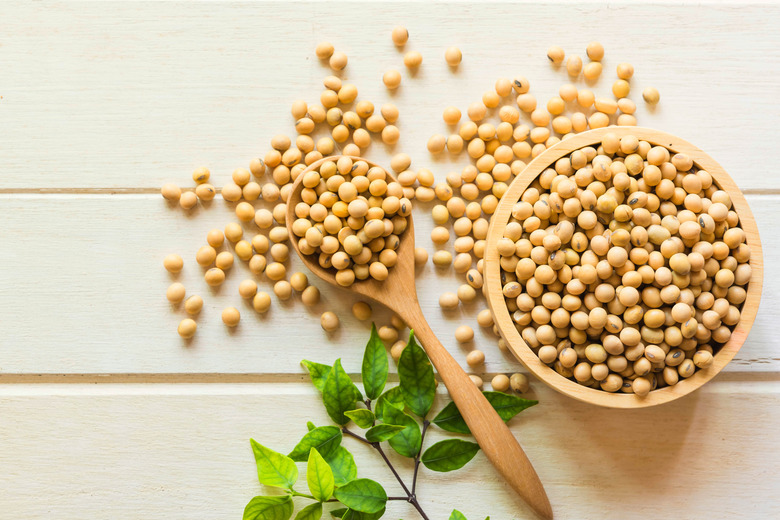How To Grow Soybeans
The soybean (Glycine max) is an industrial-scale crop in the United States and elsewhere, and it's easy to find soybeans at the store, but there are good reasons for growing them yourself. Soybeans are packed with protein, containing all nine essential amino acids, and no matter how you prepare them, they taste great. Procuring your own soybean seeds from a trusted source and growing them at home gives you access to soybeans that haven't been genetically modified to resist glyphosate and haven't been sprayed repeatedly with the controversial herbicide.
Just don't eat them raw, GMO or not, because raw soybeans cause severe digestive problems. You need to blanch soybean crops first, and one of the easiest ways to prepare them is to steam them. If you're a fan of Japanese food, you're undoubtedly familiar with this preparation method because steamed soybeans, known as edamame, are a Japanese staple. Soybeans are also the main ingredient in tofu, another Japanese staple that is popular worldwide, and you can make it at home to consume along with soy milk, tempeh, miso and other nutritious foods. You can even roast and salt dry soybeans and eat them like nuts.
Soybean plants are quite large and can reach a final height of 6 feet with a spread of 3 feet when mature, so they aren't suitable for a small garden, especially if you plant more than one. Soybeans grow on bushes like bush beans, and each bush produces white flowers with a hint of lavender coloration and 1- to 4-inch-long seed pods in clusters of five. The beans themselves can be yellow, green, gray, brown or striped and as small as a pea or as large as a kidney bean depending on which of the 1,000 soybean varieties you plant.
Best Uses for Soybeans
It's a safe bet that anyone growing soybeans is primarily interested in eating them, which is a good reason to grow more than one plant. As a rule of thumb, you should grow four to eight plants for every member of the household to ensure everyone gets a share of the crop. Soybean plants thrive only in warm weather, and even though they get big, every plant you grow is worth the extra garden space you devote to it.
The soybean plant is an annual and doesn't have much decorative value, although it might make a good border plant to add definition to the fence line during the summer months. Because it's large and you'll probably want to grow more than one, the soybean plant deserves a considerable share of your vegetable garden or even a garden all to itself. Like all legumes, it fixes nitrogen in the soil, so it's good for crop rotation with other vegetables that need extra nitrogen.
The best companion plants are corn, squash and buckwheat. Companion plants to avoid include onions and garlic. After harvest is over, you can either pull the plants or turn them directly into the soil, where they will function as a green manure and increase the nitrogen content as they decompose.
Starting Soybeans From Seed
The soil needs to be loose and well-draining, but it also needs to be rich in nutrients, so you should prepare it by mixing in organic matter such as compost and aged manure. The seeds will germinate only if they are dry, so don't soak them before planting. When sowing soybean seeds for the first time, inoculate the soil with the beneficial bacteria needed for nitrogen fixing.
Soil temperatures must be 50 to 60 degrees Fahrenheit at a minimum for successful germination. Sow seeds in individual holes that are 1 to 1 1/2 inches deep, spacing them 2 to 4 inches apart in rows separated by 24 to 30 inches. Thin the strongest seedlings to 6 inches apart when they emerge, snipping the weak seedlings at ground level rather than pulling them to avoid disturbing the roots of the remaining ones.
In What Zone Do Soybeans Grow Best?
The soybean plant is a warm-weather annual and grows best in locations with a long growing season. In the United States, the first soybeans were grown in Georgia in 1765, but today, it has become a staple crop, and you'll find soybeans in cooler regions in the Midwest United States and southern Canada, where it is often used as a rotation crop with corn.
When Should You Plant Soybeans?
In regions with cold winter temperatures, plant soybeans two to three weeks after the last frost when the soil has warmed to 55 to 60 degrees, and the average daytime temperature is between 60 and 70 degrees. In much of the country, early May is the best planting time, but in warmer regions without frost, they can be planted in late winter. Seeds germinate in five to seven days and emerge soon afterward.
In regions with a long growing season, you can plant more seeds 10 days after the first sowing to produce a second harvest. Soybeans have a long growing season; flowers may not bloom until mid to late summer followed by the seed pods. Soybean pods can be harvested for eating 45 to 60 days after sowing, but beans to be used for seeds need to mature fully and dry out, and that takes at least 100 days.
Soil, Sunlight and Water Recommendations for Soybeans
Soybeans need loose, well-draining soil that has plenty of nutrients. The ideal pH is between 6.0 and 6.8, but soybeans can survive on poor soil, so there's usually little need for soil amendments or pH adjustments other than an initial helping of organic matter, such as well-finished compost. Very poor soil may benefit from the application of a fertilizer, but do not use a nitrogen-rich one because soybeans don't need extra nitrogen — they make their own. An application of mulch is recommended to control weeds and retain moisture in the soil when the soil temperature exceeds 60 degrees.
Soybeans need to be in full sun and will also grow in partial shade, although they will produce smaller seed pods in the shade. Plants have moderate water needs, and overwatering can cool the soil and stunt growth of the plant, so mulching to retain moisture is preferable. Keep the soil moist but not wet until the flowers emerge, at which time it's safe to increase watering to produce healthy pods.
How to Propagate Soybeans
Soybeans are propagated by seed, and while you can always purchase seeds online or from your local garden center, it's just as easy to obtain them from the plants you grow. Leave one or two pods to ripen fully on the plant and remove them only when they have dried out. The beans in the pods, which will be too tough to eat, are the seeds for next year's planting. If you store them in a cool place in an airtight container, they will keep for three to four years.
How to Winterize Soybeans
The soybean plant can be grown in large containers, but since it's an annual in every growing zone, there's no benefit in bringing the containers indoors for the winter. When planted in the garden, you may want to cut down the plants after harvest and turn them into the soil to increase the nitrogen content.
How to Harvest Soybeans
The best time for harvesting soybeans for the table is when they have ripened about halfway — while the green pods are plump but still soft and are 2 to 3 inches long. Each pod contains four or five beans that fall out readily when you crack open the pod. It's important to blanch the fresh beans before storing them or eating them by immersing them in boiling water for two or three minutes and then dunking them in an ice-water bath. Sprouted soybeans should be boiled for five minutes before you eat them.
When harvesting soybeans for seeds, allow them to mature fully on the plant and dry out. Pull up the entire plant and hang it upside down to dry. Then, store the dry beans after shelling them.
Common Pests and Other Problems for Soybeans
If allowed access to your soybean crops, deer and rabbits will decimate the foliage in short order. As a matter of course, you should erect fencing around all your leafy crops, but failing that, a regular application of Liquid Fence around the garden area may do the trick, although it's less likely to be a deterrent in times of drought when food is scarce. Gophers can also decimate a soybean crop and should be excluded by an underground barrier of gopher wire.
Besides these mammalian varmints, which are easy to spot if you're on the lookout for them, there are a number of insect pests that aren't so easy to see. There is a fairly long list, but some are common:
- Aphids (or more specifically, soybean aphids) create colonies on the leaves, sucking the juices and leaving deposits of sticky honeydew, which promotes the growth of sooty mold. Ants love honeydew, so a trail of ants on a stem is usually an indication of an aphid infestation. You can usually dislodge aphids by spraying the leaves with water, but soybean leaves are too fragile for that. A better treatment strategy is an application of insecticidal soap.
- Mexican bean beetles look like orange-colored ladybugs, and they are most active during the mid to late summer, when they feed on the leaves. Covering the plants with row covers is one way to exclude them, but once an infestation occurs, you may have to use an insecticide.
- Slugs and snails are most active before the weather turns hot, and they do most of their damage to young plants. They move slowly, but they're good at hiding, and you may only see their trails. You can control them with slug and snail bait.
Common Diseases for Soybeans
Soybeans are vulnerable to the same array of bacterial blights and fungal diseases that affect other plants, and some cause unsightly blemishes and rotting on leaves and stems, but few affect soybean yields.
- Root rot most often affects young seedlings, and affected plants usually die. One of a number of soil pathogens could be responsible, including Pythium, which is a fungal-like organism called an oomycete, and Fusarium, which is an actual fungus, but the real cause is usually wet soil. Avoid overwatering soybean seedlings.
- Powdery mildew (a fungus) can form on the tops of the leaves and downy mildew (a type of mold) can form on the undersides, and while the leaves may be disfigured, the beans are usually unaffected. These are two different diseases, but you can usually treat them the same way by using a fungicide or spraying the plants with hydrogen peroxide.
- Alfalfa mosaic turns the leaves yellow and can stunt plant growth. It is spread by aphids and frequently shows up on the outer fringes of the crop first, especially near alfalfa plants. Treat it by spraying the aphids with insecticidal soap, and avoid planting your soybeans near alfalfa in the future.


